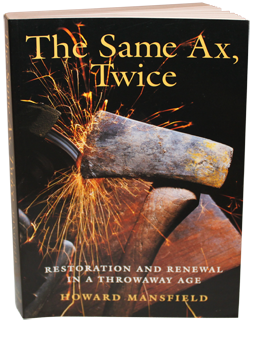THE SAME AX, TWICE: RESTORATION AND RENEWAL IN A THROWAWAY AGE
UPNE, ISBN: 1584651172
From the Introduction
Back when I went to school, there was an administrator, a vice-president of something or other, who was given to rough-hewn statements, the kind of homilies that were meant to show his populist stuff. He was particularly set on tearing down the wooden houses on campus. They just weren’t practical.
We said: They can be repaired. There are wooden houses that have stood for hundreds of years. And all buildings, no matter the material, need repair and renewal.
He said: I know a farmer who says he has had the same ax his whole life—he only changed the handle three times and the head two times. Does he have the same ax?
I did not have a good reply then. But in the twenty years since, talking with preservationists, carpenters, and architects, I have come to realize that so many controversies about saving and rebuilding are to be found in this one old joke. The debates about the restoration of the Parthenon or about the vinyl siding your neighbor has put on his 1789 cape come down to this one question: Do we have the same ax? I would answer with two riddles.
From A Moment’s Bright Flash
One man at the engine show had built a small scene around a barrel of water. A hired man works a hand pump to fill the barrel, but it never fills. A pump continuously takes away the water, leaving this machine-driven man at his task eternally.
In the Tao there is this story. A learned master, famous throughout the kingdom for his scholarship, was out for a walk in the country with his disciples. They came upon an old man toiling to water his garden. With great effort, but little result, he was hauling jars of water from the well. The learned master told him he should use a shadoof, a long pole weighted at one end to automatically dip a water bucket at the other end like a see-saw. With a shadoof he could irrigate a hundred gardens with less effort than he used now.
The old gardener gave the master an angry look, then laughed. His teacher had taught him that “ingenious contrivances” were the work of a “scheming mind” and impaired “pure simplicity.” “When this pure simplicity is impaired, the spirit becomes unsettled, and the unsettled spirit is not the proper residence of the Tao.” He knew of this water-moving “contrivance” but he would be “ashamed to use it.” The learned master was humbled into silence. The gardener’s simplicity, he said later, was vast and complete.
Here in this one Vermont field is a legion of men ready to rush forward to lift water dozens of different ways, with pumps, water hammers, and water ramps.
This inventiveness is our glory and defeat. This is the one trick we know, the way we’ve created one kind of wealth, created plentitude, but lost fullness.
“Discontent is the first necessity of progress,” said Thomas Edison. “Show me a thoroughly satisfied man, and I will show you a failure.”
At the antique engine show they played a game with the tractors. Each competitor drove around with a bag on his head. A blind race. They had to drive to a specific spot. No peripheral vision. A fun game, or a damning image if you think about it.

